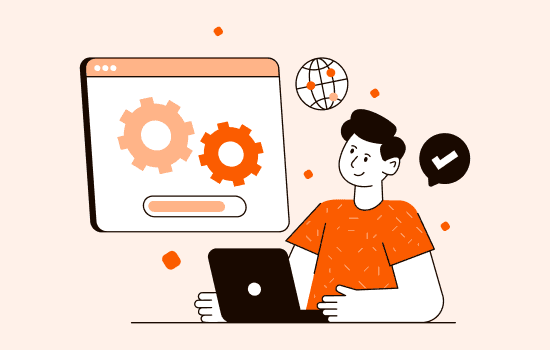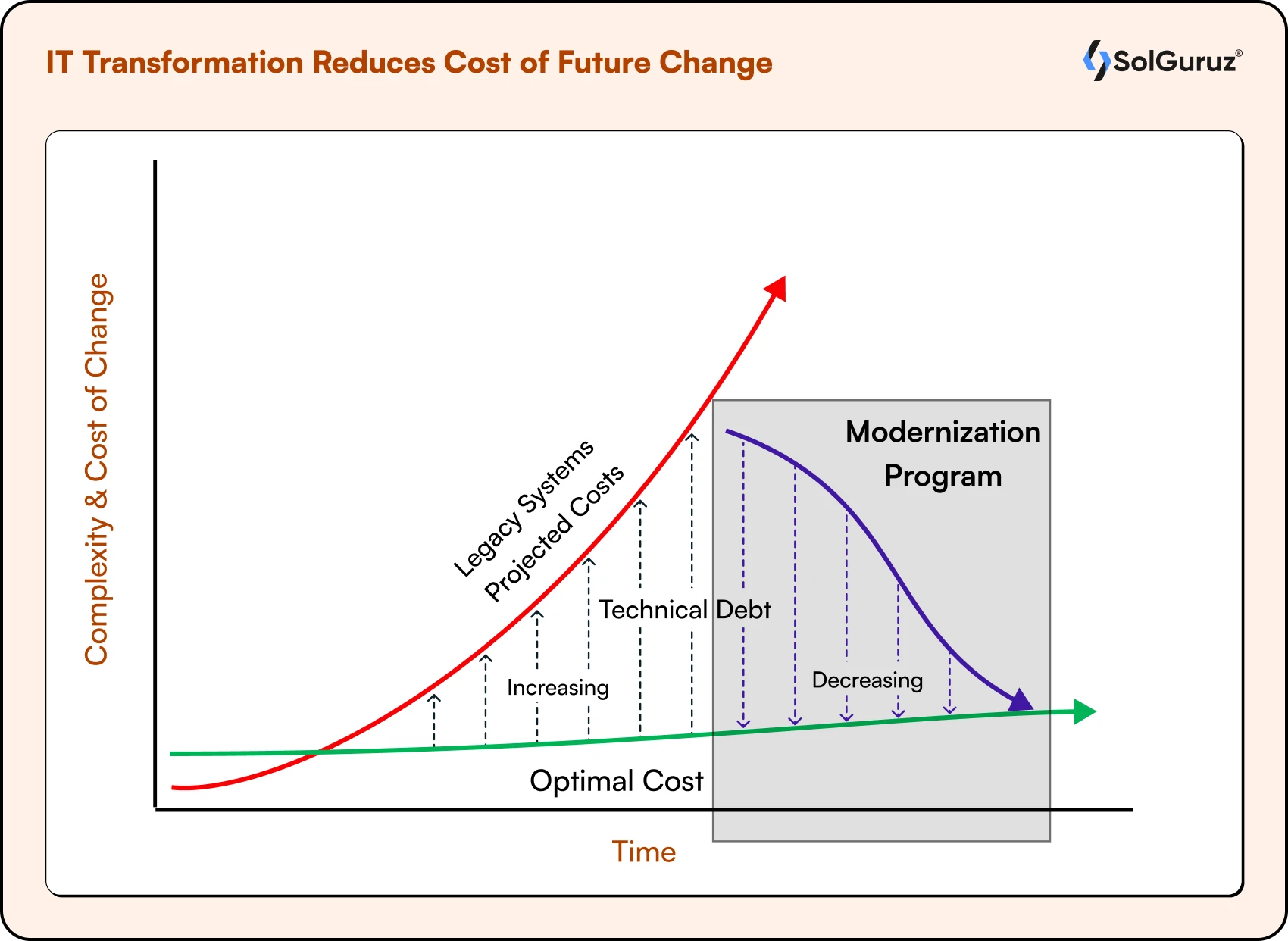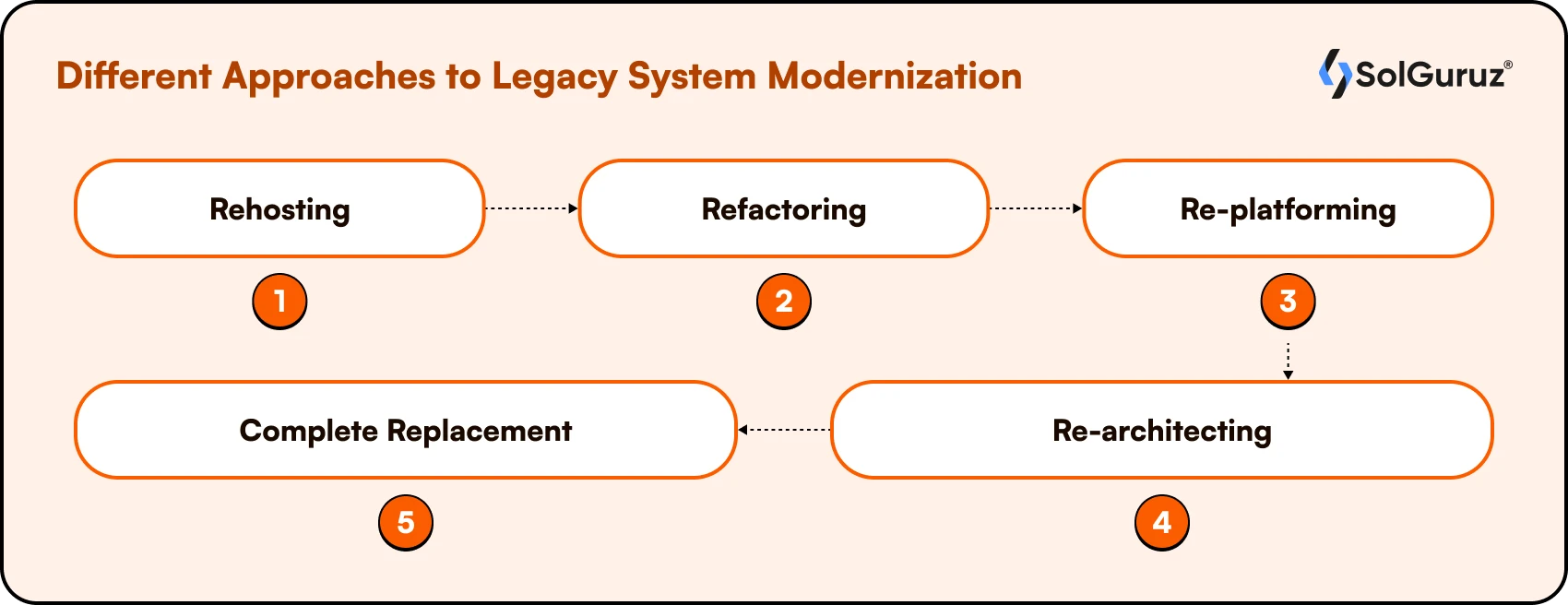Engineering Quality Solutions
Master the art of legacy system modernization with our in-depth guide to overcoming challenges and improving your business ROI with legacy application modernization.

“The old ways won’t open new doors.”
But modernizing old can open new doors for not only business but for opportunities as well. This is the case with legacy systems or outdated systems. Legacy systems (old ways) need a modernization touch (new doors), and legacy system modernization is the prime answer to the need.
Businesses must make critical choices when starting a legacy system modernization project, such as whether to enhance current software, replace obsolete systems, or reorganize programs that impede corporate goals. This approach helps organizations to overcome obstacles, embrace innovation, and maintain their competitiveness. It is not merely technological.
In this blog, we’ll explore some critical queries about modernizing legacy applications. We will examine the advantages of the same as well as make you understand how legacy system modernization can double your business ROI, which can provide companies with a competitive edge in today’s fast-paced market.
This blog will provide you with the information and resources you need, whether you are a company leader looking for ideas for sustainable growth or a CIO determining the future of your organization’s digital landscape.
Any outdated system that is still in for day-to-day use. Quoting Gartner’s words, “An information system that may be based on outdated technologies but is critical to day-to-day operations.”
A very relatable example of the legacy system is “Windows XP” or, for that matter, “previous Windows versions.” These versions now do not have the updated features, and neither do they have upgraded security features. The company has even stopped releasing support for them.
Why do we feel the need to be updated? What is the reason that when the latest information and the latest system updates arrive on the market, we are in a hurry to implement them?
Staying relevant and competitive in today’s era is not a ritual it is a necessity.
And above all, the fear of becoming obsolete. As soon as you are less competent, you become replaceable. When you come across these characteristics very often, it is time to get updated.
Modernizing the legacy system means updating the system with updated features and, if possible, upgrading the software platform and architecture.
Again, going by the Microsoft Windows example, remember that whenever a new operating system is launched, the company provides the latest version for its customers. When you opt for the higher version, your system is upgraded. You do not have to throw the system away to get an updated version of the software.
Similarly, with legacy system modernization, your old system gets upgraded and modernized to give you the best output. In addition to addressing the shortcomings of old technologies, this transformative process makes sure that it is in line with security guidelines, industry standards, and changing business needs. Organizations can improve overall performance, scalability, and operational efficiency by updating their aging systems. By doing this, they further strengthen their position for long-term success in the ever-changing digital market.
When you do not update the system, it becomes
It is very well understood from the needs of legacy system modernization that an outdated system has many lacunas and, if not treated at the right time, can turn into significant issues causing damage to the project or maybe to the organization. In the above section, we have discussed the problems; let us look at the benefits of bespoke software development application modernization services –

In the above section, we understood the benefits of legacy system modernization, but migrating to the latest technology from legacy systems is a daunting job. Replacing legacy applications and systems with new and different technologies is not only a challenging but tedious task. A few of the challenges legacy system modernization faces are:

Technical debt is one of the drawbacks of modernizing legacy systems. Simply put, it is the shortcut taken by a developer to resolve a problem requiring a detailed, well-thought-out approach.
Technical debt frequently makes modernizing legacy apps a problematic task. In software development, “technical debt” is a metaphor for the results of selecting a fast fix for an issue over a more thorough and responsible course of action.
Technical debt arises from unintentional choices made by software development teams or individuals who sacrifice the code quality or take shortcuts in order to satisfy short-term development deadlines or goals. This is frequently due to the fact that efficiently updating the system can take time. These shortcuts may lead to substandard coding or solutions that do not always deal with the underlying source of the problem. A few corrective measures can be –
Modernization initiatives must prioritize security. Modernization offers a chance to update and strengthen security protocols. Integrate security early to guarantee the security of modernized apps. Application modernization services make security a fundamental part of the application’s architecture and design by incorporating it into the modernization process from the start.
Perform a risk assessment: To find potential threats that might surface during modernization, perform a thorough security risk assessment.
Specify the conditions and goals: Clearly state the updated application’s security expectations and needs. Data protection, access restrictions, encryption, and regulatory compliance are a few topics that this should address.
Assure adherence: Finally, confirm that updated systems abide by applicable laws and that a routine procedure is in place to maintain compliance.
The end user and the process are frequently uncoordinated when a legacy system is redesigned and reengineered. One of the main problems with migrating historical programs is that users will have a challenging time understanding and utilizing the system. If this is not addressed—ideally through training—poor employee engagement may result.
Whenever legacy systems are modified due to the process, there comes downtime when operations come to a halt. Business operations may be impacted by downtime during a move. We will look at techniques to reduce downtime, guarantee a smooth transfer, and lessen any workflow interruptions.
Finding a developer who is skilled in legacy systems as well as modern technologies becomes a challenging task for organizations. One way to resolve this is upskilling the existing employees. Another is to hire employees who are skilled in the respective requirements.
Legacy software (age-old software) used by legacy systems makes it difficult for them to interact with more recent innovations.
Data silos result from this lack of integration. It denotes that data is isolated and difficult to exchange or access between many departments or systems. These legacy difficulties impede efficient decision-making and data analysis. Furthermore, your company’s capacity to implement cutting-edge solutions like cloud computing or advanced analytics may be constrained by its incapacity to integrate with new technology.
Businesses may still be utilizing legacy systems, which are outdated hardware or software. These technologies have some unforeseen expenses that could negatively impact an organization’s productivity and profitability, even though they may still be helpful. Here are a few unstated costs related to outdated systems:

System and application management becomes a daunting task, especially with legacy systems. Every time any major update or modification incurs complexity. Resolving such complexities can cause bugs. This is again not desirable. A basic modification has the potential to cause a time and money investing problem. The ramifications may include more time from the experts to resolve any issue or to invest more money. Sometimes it can be both.
As systems age, vendors decline support for them. This results in hardships in managing the systems without vendor support. Vendors are more interested in new technologies that can earn them more money. Therefore, if you have been depending on outside software suppliers, it will be even harder to maintain the program operating in the event that they quit entirely offering support.
“How many of your developers can fix an issue with COBOL?”
Legacy skill set needs experts who know the tech in and out to resolve any minor or major issue. If those with the knowledge of legacy systems retire, the talent pool shrinks. A legacy skill set is necessary for maintaining a legacy system. The market inclination towards more modern technology automatically worsens the situation. More so, the skill gap creates a challenge in the workflow.
It is challenging to alter the majority of outdated systems. What occurs then if you need to implement a new application or feature for the company? Projects tend to go longer and over budget, here is what happens. Over the course of the endeavor, you keep running into obstacles. It takes time to test new features because it is hard to gauge how well everything works with the current system. The expenses of integration also usually increase with these developments.
We have seen that App modernization has hidden costs which were discussed. But how can it be of advantage and help increase the ROI of your business? Let us see
One of the many commercial advantages of enterprise application modernization of outdated systems with new enterprise apps is a notable increase in return on investment. Through process simplification and workflow optimization, businesses can increase operational effectiveness, resulting in significant cost savings and improved customer experiences.
A McKinsey study states that companies that improve customer experiences usually see growth of 5 to 10 percent and cost reductions of 15 to 25 percent. Another significant benefit that businesses may get from updating their IT assets is improved cybersecurity.
The deliberate transition from outdated systems to flexible, customized solutions promotes innovation and scalability, generating significant returns on investment and setting up companies for long-term success in the digital age. Custom software solutions for legacy systems are another great option to opt for if you are dealing with an End-of-Life legacy system.

Depending on your organization’s unique goals and circumstances, there are several ways to modernize legacy applications. The existing state of the application, financial restrictions, and the intended result all play a role in the approach selection. Legacy application modernization services can take various approaches to enterprise application modernization. They can be –
Rehosting is the process of moving old applications to a new setting while keeping the majority of its functionality and code the same. When a speedy transition is necessary, it is a good option, although it might not fully utilize modernization. Knowing how source code is organized and arranged in a software program requires a comprehension of its code structure.
It is the process of reorganizing and streamlining current code to increase maintainability and performance without compromising its essential features. This tactic may work well to increase the productivity of an application.
Replatforming is the process of transferring legacy applications to an alternative infrastructure or platform. This requires some code change but can result in scalability and performance gains.
Re-architecting is the process of completely reworking the application’s architecture to conform to contemporary guidelines. It frequently calls for a phased strategy that efficiently manages the process while resolving architectural concerns.
When legacy systems are sufficiently antiquated, a complete replacement might be required. Although this approach offers a new beginning, there is a risk of disturbances throughout the shift.
The various approaches were covered in the section above. But here are different types of legacy systems that require different degrees of updates to modernize. They are:
End-of-life legacy systems are perhaps the most prevalent sort of legacy systems. In actuality, EOL systems have a very straightforward explanation. Developers and vendors are also businesses. They also have to keep up with emerging technological trends. This typically translates to systems built with older legacy software losing maintenance due to a loss of resources and knowledge or becoming too costly to maintain. When this happens, vendors stop selling the products and offer updates or support for EOL legacy systems.

Every software comes with a limited lifespan. Once the lifecycle is over, the support can be in the form of updates or patches, and after some time, the support is also stopped by the vendor. As in the case of Windows XP, we see that Microsoft has now stopped any kind of support for the operating system. A comparable situation is for legacy systems. Either the system owner must move to a similar alternative, or they must switch the software completely.
Age-old software and systems that were created while a particular type of infrastructure was accessible. As such, they are unable to support emerging technologies like artificial intelligence (AI), the cloud, and big data. In this situation, a new option will need to be investigated because the legacy solution will not be able to expand with the business.
For instance, COBOL is a primitive programming language, and knowledge of it can help develop novel ideas, but it is unable to support the latest modern programming languages. Hence companies went on modernizing the language and made the shift to new languages.
Considering the inherent complexity of modernization, picking a skilled partner is crucial. Here are some things to consider before choosing:
Experience with related app modernization initiatives: Previous results are a good indicator of future performance, and having worked on related projects before helps one avoid potential pitfalls.
Knowledge of your company: The ideal partner is conscious of the particular difficulties faced by your sector. This is essential for customizing the roadmap for app modernization.
A thorough approach to system architecture: Seek a partner who can articulate their approach to designing and constructing your new system with assurance and clarity. This demonstrates their level of competence.
Deep Technical Knowledge: It is advised to partner with a company that has expertise in the domain of legacy system modernization and thorough knowledge of architectures, microservices, platforms, and other things.
SolGuruz is a leading name in the industry for legacy system modernization, with detailed knowledge of migrating legacy systems to the latest technology. Through native connections to core systems and application architectural alignment, SolGuruz facilitates smooth and rapid data interchange, maximizing the capabilities of an organization’s current infrastructure.
The different approaches to migrating the legacy systems are rehosting, refactoring, re-platforming, and others. The approaches are decided by looking at the situation at hand when dealing with legacy systems.
Outdated systems not only hold back growth but also incur costs for your business. Maintenance cost is one case that you have to bear if you are working with legacy systems.
The most suitable method can only be decided when you discuss the issues with the legacy software modernization company. The experts can better understand the situation and recommend the best possible solution to you. Sometimes you can opt for custom software solutions as well while migrating to the latest technology.
System migration causes data losses and may cause compatibility issues. However, a suitable legacy software modernization company can suggest the best solution while understanding your system requirements and your business requirements.
Written by
As a Co-Founder and COO at SolGuruz, Satendra is a thought leader who brings extensive experience in product management to the table. With a proven track record of working closely with startups and enterprises, Satendra is dedicated to helping businesses achieve their goals by developing and implementing effective product strategies. At SolGuruz, we believe in delivering a combination of technology and management. Our commitment to quality engineering is unwavering, and we never want to waste your time or ours. So when you work with us, you can rest assured that we will deliver on our promises, no matter what.
Upgrade your legacy systems with SolGuruz. Our modernization services ensure your technology keeps pace with your business needs.

1 Week Risk-Free Trial

Strict NDA

Flexible Engagement Models
Give us a call now!

+1 (646) 703 7626
Discover the latest tech trends from SolGuruz - empowering businesses with innovative solutions and transformative insights!